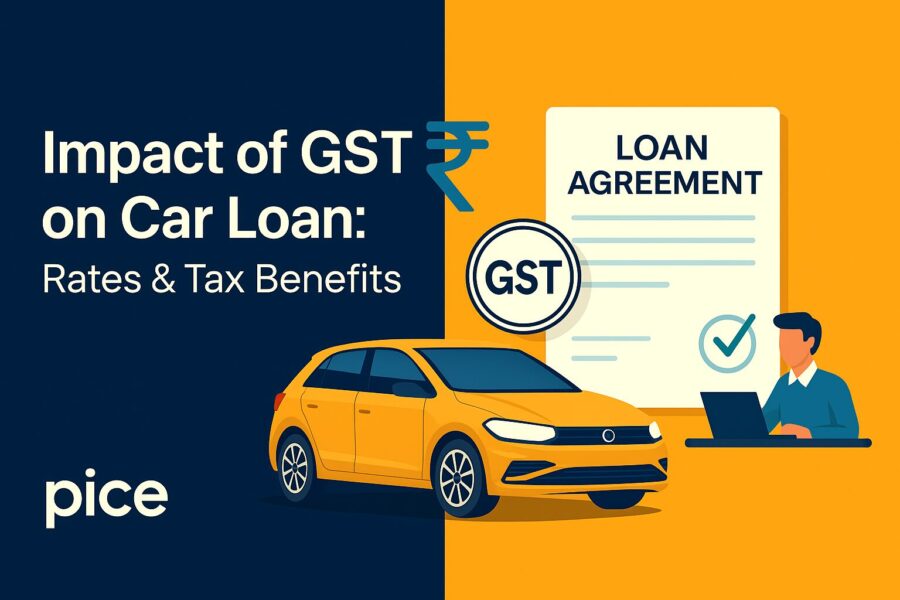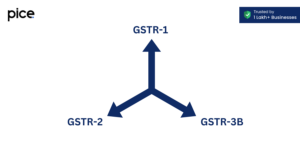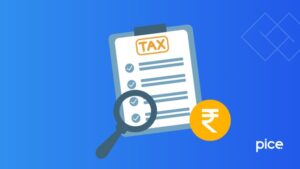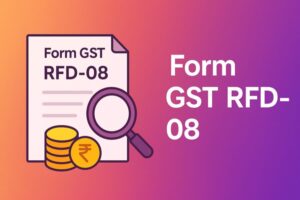Impact of GST on Car Loan: Rates & Tax Benefits
- 17 Nov 25
- 8 mins

Impact of GST on Car Loan: Rates & Tax Benefits
Key Takeaways
- GST on cars ranges from 29% to 50% depending on engine capacity, car type, and compensation cess.
- Electric vehicles enjoy a reduced 5% GST rate, making them significantly cheaper post-GST.
- Post-GST, small cars became slightly cheaper while luxury cars and SUVs saw marginal to moderate price changes.
- Used cars attract GST only on the dealer’s profit margin, making pre-owned vehicles more affordable.
- GST allows manufacturers and dealers to claim Input Tax Credit (ITC), reducing overall manufacturing and supply chain costs.
With the Government’s decision to increase GST on cars from 12% to 18%, and a 18% GST on car loan processing fee, the Indian car market has witnessed a sharp slowdown.
GST implementation has impacted car purchases and sales significantly in India. Let’s find out if the GST imposition has increased or decreased the overall car price in India.
What is GST on Cars?
Cars come under the 'supply' as defined by the GST law without exemptions. However, if a physically disabled person uses a vehicle, it is exempt under GST. Moreover, if you purchase used cards from unregistered dealers, it is not subject to taxation as per forward charge mechanism.
For instance, the GST on petrol cars under 1200cc is 28% with 1% cess. However, luxury cars attract a higher GST rate, which affects car prices. Notably, as GST rates are predictable, car buyers can estimate the cost of cars, unlike pre-GST times.
The following table illustrates the GST rates and cess on different vehicles:
| Car Category | Engine Capacity & Length | GST Rate | Compensation Cess | Total Tax Rate |
| Small Petrol Cars | Up to 1200 cc, less than 4m in length | 28% | 1% | 29% |
| Small Diesel Cars | Up to 1500 cc, less than 4m in length | 28% | 3% | 31% |
| Mid-sized Cars | Above 1200 cc (petrol) or 1500 cc (diesel) | 28% | 15% | 43% |
| Luxury Cars | Above 1500 cc | 28% | 20% | 48% |
| SUVs | Above 1500 cc, more than 4m in length | 28% | 22% | 50% |
| Electric Vehicles | All capacities | 5% | 0% | 5% |
Car Price Comparison in India: Before and After GST
The table below highlights a comparison between tax rates in the pre-GST and post-GST eras:
| Car Category | Pre-GST Tax Rate (Approximately) | Post-GST Tax Rate | Price Impact Post-GST |
| Small Petrol Cars | 31-33% | 29% | Minor price decrease |
| Small Diesel Cars | 33-35% | 31% | Slight decrease |
| Mid-sized Cars | 40-45% | 43% | Moderate increase |
| Luxury Cars | 50-55% | 48% | Notable price drop |
| SUVs | 50-55% | 50% | Mostly stable |
| Electric Vehicles | 20-30% | 5% | Significant decrease |
The illustration below presents the estimated price difference due to GST imposition:
| Component | Pre-GST (₹) | Post-GST (₹) |
| Ex-Showroom Price | 5,00,000 | 5,00,000 |
| Excise Duty @12.5% | 62,500 | - |
| VAT @14.5% | 72,500 | - |
| Infrastructure Cess @1% | 5,000 | - |
| Other Taxes (includes state-levied taxes) | 7,500 | - |
| GST @28% | - | 1,40,000 |
| Cess @1% | - | 5,000 |
| Total Taxes | 1,47,500 | 1,45,000 |
| Transportation, Sales | 35,000 | 35,000 |
| Total Price | 6,82,500 | 6,80,000 |
What Is the Value of Supply on Cars?
The money that a seller receives from a buyer in exchange for goods and services is the value of supply under GST. If related parties are associated, the transaction value attracts GST. Transaction value is the value at which an unrelated party transacts in the normal business course.
The value of supply excludes any discount provided by the dealer before the sale and mentioned on an invoice. However, if a discounted amount is not mentioned on an invoice, the total amount attracts GST.
Notably, post supply discounts are deducted from the taxable value in the below-mentioned conditions:
● The discount needs to be provided based on an agreement with customers.
● This agreement needs to be executed prior to or at the time of supply.
● The customer needs to reverse ITC (Input Tax Credit).
● This discount needs to be associated with a relevant supply invoice that the taxable person issued initially while supplying the goods.
A dealer might collect additional amounts as a pure agent, such as insurance, registration charges or credit card swiping charges. These charges will not attract GST. However, if the dealer collects additional charges, it will attract GST.
Differential Tax Rate for Cars
A differential tax rate applies to the leasing of vehicles. If you lease a vehicle prior to 1st July 2017, it would attract a 65% GST, including compensation cess. It would further attract GST at the time of sale, according to Notification 37/2017 Central Tax.
GST on Import of Cars
Import of cars attracts IGST (Integrated Goods and Services Tax) wherein you need to consider assessable value in addition to basic customs duty to calculate IGST.
For instance, if the assessable value is ₹5,00,000, basic customs duty is ₹50,000, then the value to charge IGST is ₹5,50,000. IGST at the rate of 28% is ₹1,54,000.
The government has levied this tax to promote domestic goods 'Made in India'. The tax on semi-knockdown kits of passenger cars has been increased from 15% to 30% and completely knocked down kits from 10% to 15%. As customs duty is included in the charge, the value of IGST increases, which in turn increases the price of the product.
Exemptions of GST on Vehicles
Here are the four types of vehicles on which the Indian Government allows GST concession:
● Electric Vehicles: To promote green mobility, the Indian Government levies only 5% GST on EVs.
● Used Cars: Pre-owned cars are more cost-effective as GST is imposed on only the profit margin and not on the entire price. If you sell a used car at a loss, no GST applies.
● Ambulances: The Government levies only 12% GST on this type of vehicle.
● Vehicles for Persons with Disabilities: To ensure mobility and independence, the Government imposes GST discounts for these vehicles.
ITC on Motor Vehicles
Under Section 17(5), ITC is not allowed to motor vehicles that transport less than or equal to 13 persons, including the driver. The following vehicles, however, can benefit from the ITC allowance:
● If an employer provides a car to an employee for business purposes, under Section 17(5) clause (a) and (aa), ITC can be claimed. However, if the vehicle is used for personal or non-business purposes, no ITC can be claimed.
● As demo cars at dealership stores are capital assets and are not used for retail sale, a dealer can claim ITC on them.
● Under Section 16(1), registered persons can claim ITC on services or goods used for the furtherance of business. Further, you can claim ITC on leasing or renting motor vehicles with a capacity exceeding 13 persons under Section 17(5) amendment.
● If you are a person in the transport business, purchasing vehicles for passenger transport, you can claim ITC.
How Does GST Impact Car Prices?
Compared to the pre-GST era, when VAT (Value-added Tax) was applicable, GST has reduced the overall tax rates and thereby car prices. In the post-GST era, taxes are levied on the consumption state and not the original state.
Benefits of GST on Vehicles
1. Consumer: Purchasers need to pay lower taxes on automobiles in the post-GST era compared to the pre-GST era, where VAT was high.
2. Manufacturers: As excise duty has reduced with the implementation of GST, the overall manufacturing cost has decreased. Manufacturers can claim ITC on raw materials, lowering their outward tax liability.
3. Dealers/ Importers: Prior to the GST introduction, dealers and importers were not allowed to claim VAT and excise duty. However, after GST implementation, importers can claim paid taxes, helping them reduce their costs.
Conclusion
GST on car loans have significantly changed along with tax imposition on vehicle purchases and rentals. However, GST imposition has lowered the taxes applicable on vehicles, as compared to VAT.
As a result, purchasers need to pay a lower total purchase price for cars. GST implementation has thus simplified the taxation on vehicles in India.
💡If you want to streamline your payment and make GST payments via credit, debit card or UPI, consider using the PICE App. Explore the PICE App today and take your business to new heights.
 By
By 

















